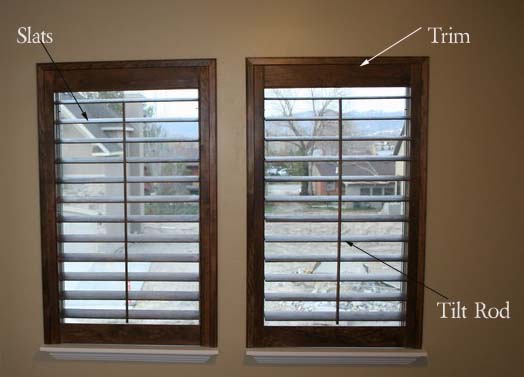It’s important you’re well informed about shutter basics, wood types and other considerations before purchasing shutters for your home. Utah Shutters is happy to help you make an informed decision before you make your purchase. To do so Utah Shutters provides some quick primers on important shutter topics. For even more in-depth information about shutters for your home check out the “Utah Shutters blog!”
Shutter Basics – How a Shutter Works

Shutters consist of three main parts. These main parts are the fitting around the window known as the trim or Z-molding, the slats (louvers) themselves and the tilt rod (like a draw string on mini-blinds).
Shutter Trim
The trim in relation to the window is usually installed in one of two ways. The first option is to have the shutters completely encased within the window frame (as seen in the picture to the right) and the baseboards or standard trim around it. This option is popular because it completely controls the elements and is often slightly cheaper due to less customized installation and design. The second option is to have the actual shutters installed with its own window framing protruding away from the window. These installations are typically done when there is not large enough window seal area for the shutter and window to function properly together. In addition to how the trim is installed there are also different types of trim for shutters. Utah Shutters offers a standard slate of trims. These trim samples are part of Utah Shutters’ free in-home quote process so the customer can properly choose which type of trim is best for their home.
Shutter Louvers
The second main part of shutters are the shutter slats themselves. These slats are technically referred to as louvers. These louvers go a long way in determining how much light is allowed into a room and the design of the actual shutter itself. The most common louver sizes are 4.5 inches and 3.5 inches. Additionally there are louvers that are 2.5′. The 2.5′ louvers are usually seen in colonial or Victorian homes while 3.5′ and 4.5′ louvers are often seen in newer homes and on larger windows so as to ensure aesthetic appeal. Though these are not the only sizes that are common as louvers also come in sizes both bigger and smaller than those listed. Utah Shutters produces shutters with louvers in both the 3.5′ and 4.5′ variety – which are most common in modern homes. Ultimately this aspect of your shutters is dependent on your preference and the ability of the company making them.
Shutter Tilt Rod
Last but not least of the shutter puzzle is the tilt rod. (Sometimes referred to as a push rod.) The shutter tilt rod is the vertical rod that hangs from your shutters. This rod is akin to the drawstrings that are often seen with modern day store-bought mini-blinds. This rod is the tool used to both open and close the shutters as well as adjust the tilt of the louvers. Most tilt rods run vertically down the center of the shutter as pictured above. Other shutters sometimes feature what is called a “hidden tilt-rod” which runs vertically along one edge of the shutter so it doesn’t obstruct the view of someone looking through the window. Utah Shutters currently makes shutters with a middle tilt rod as well as shutters that feature the hidden tilt rod.
Shutter Sizes
Shutters, and by extension Utah Shutters custom plantation shutters, come in all different shapes and sizes. While many people may wonder if their oddly shaped windows, arched windows or doors are too un-traditional for shutters the fact is that shutters can be very versatile by being custom built and designed. This versatility is a big draw over store-bought mini blinds or shades that only come in certain sizes or in the best case scenario can be custom ordered and after weeks of waiting still not have a shade that properly fits the window. As can be seen in the photo gallery of shutters Utah Shutters has years of experience designing custom shutters no matter the size or shape!
Shutter Wood Types
Shutters today can be built with a few different materials. Wood is the most popular type of material to be used when making shutters. Types of wood that are often used are basswood, poplar, oak, cedar, alder and maple. Another option for shutters is vinyl but due to the inability to customize the shutter and the lack of durability Utah Shutters does not produce nor offer these types of shutters. Additional types of shutters include composite (wood and plastic combined), aluminum and even fiberglass in some cases.
